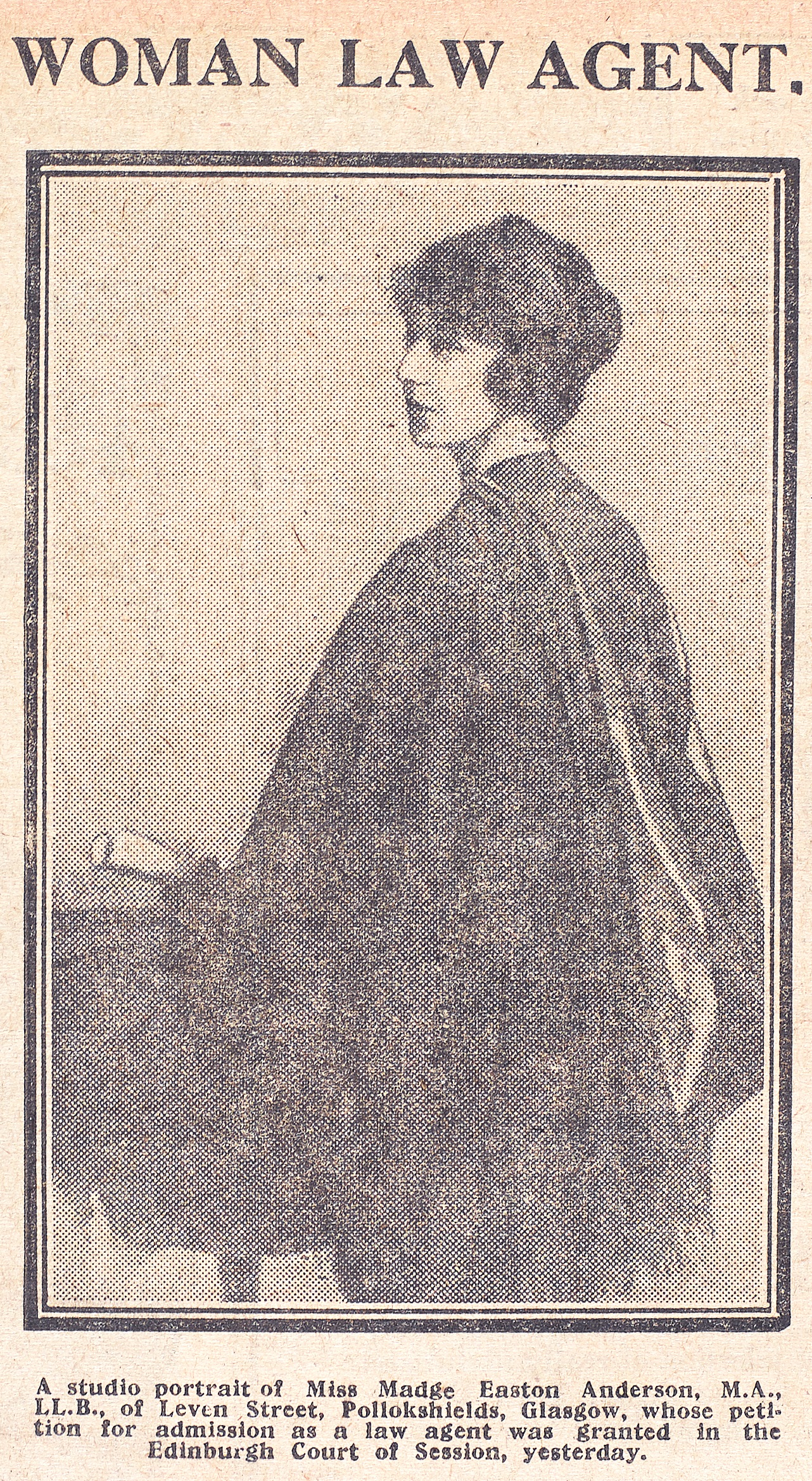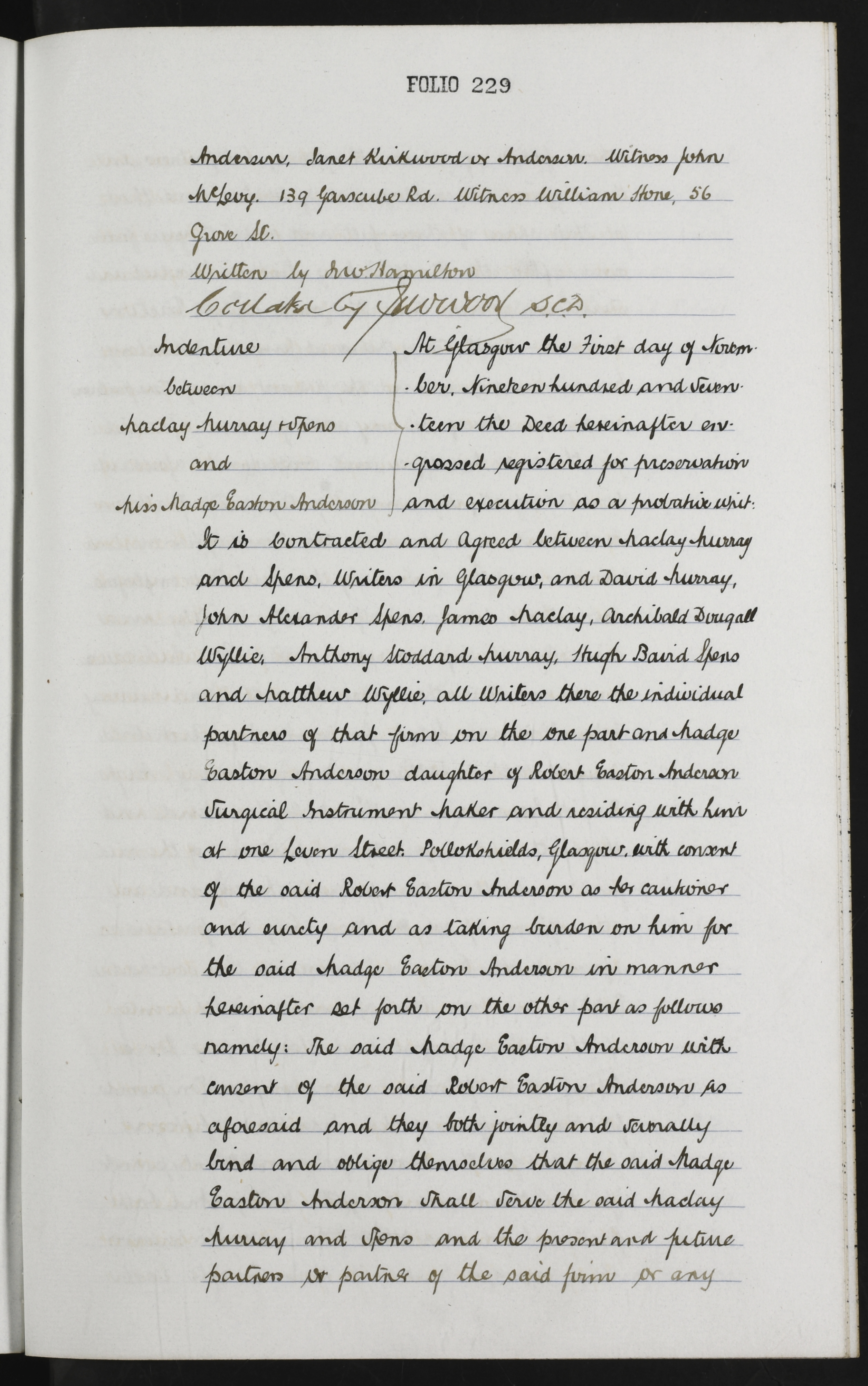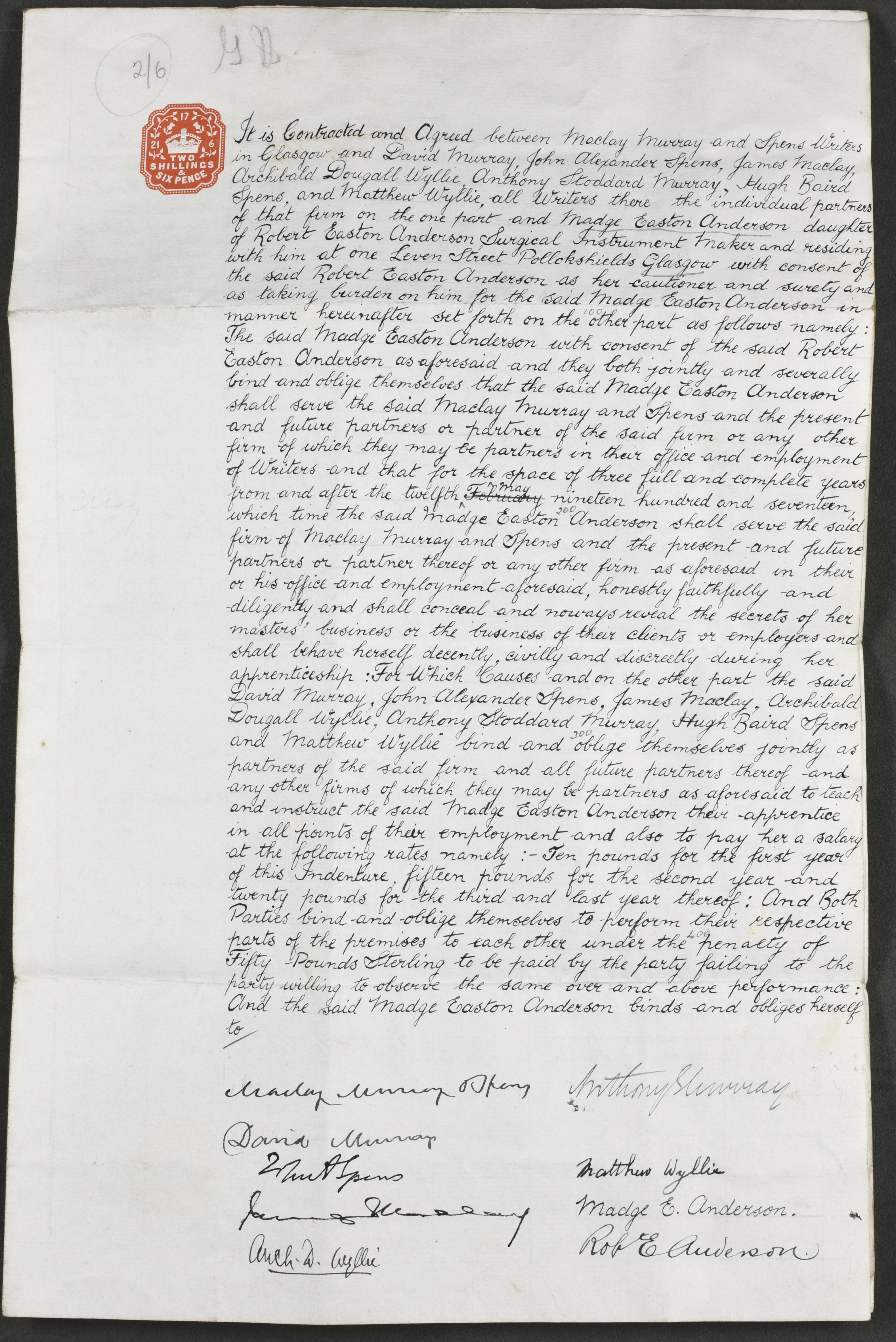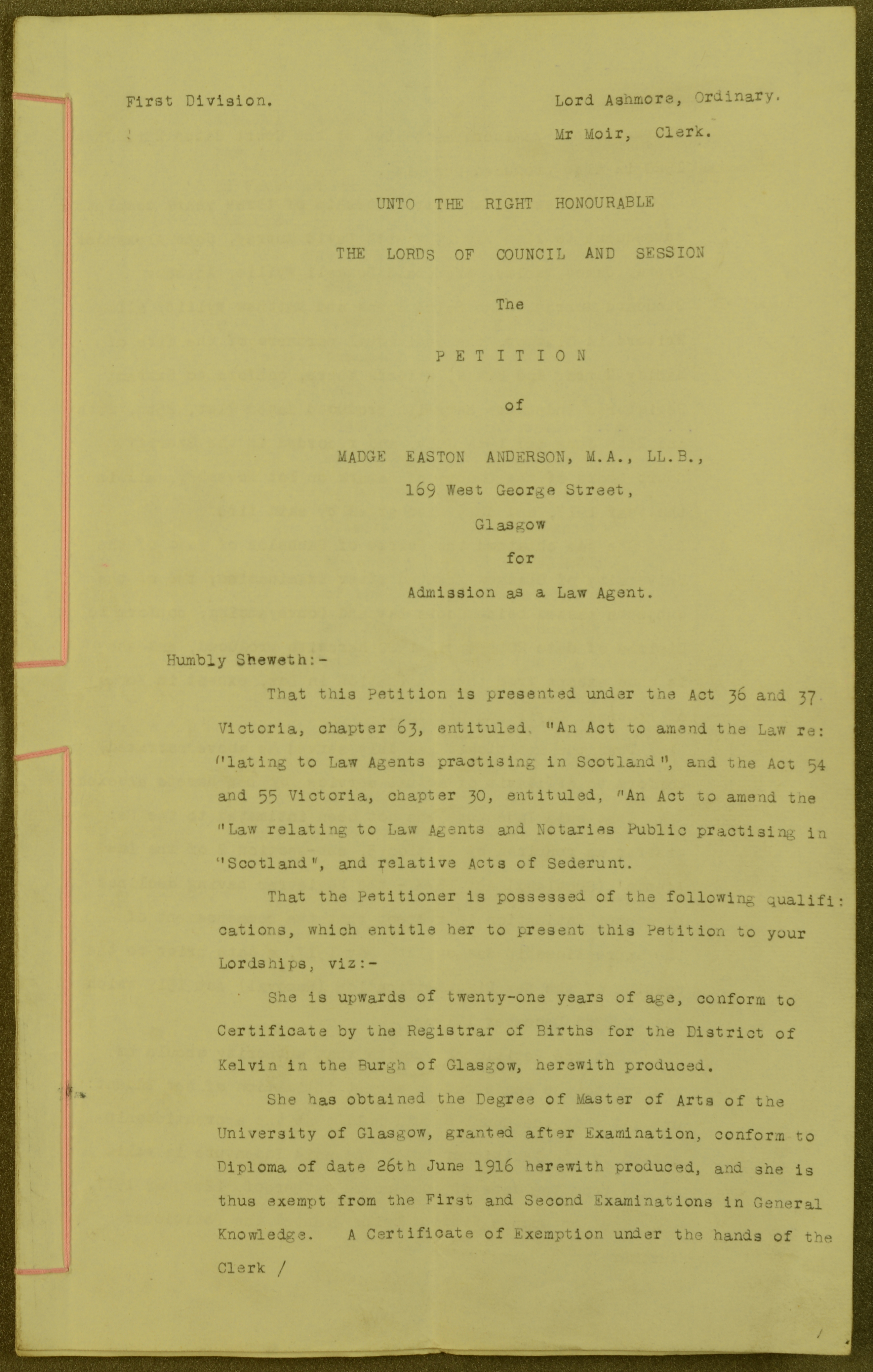Woman Law Agent: Madge Easton Anderson
Woman Law Agent: Madge Easton Anderson

‘Woman Law Agent’, The Daily Record, 16 December 1920. ©CSG CIC Glasgow Museums and Libraries Collections: The Mitchell Library, Special Collections
In 1921 Madge Easton Anderson was the first woman in Britain to qualify as a solicitor, in 1937, the first woman to qualify to practice in both Scottish and English law and she went on to become a partner in Britain’s first all-female law practice.

Birth entry of Madge Easton Anderson
Crown copyright, National Records of Scotland, Statutory Register of Births, 1896, 644/9 669
Born at 75 Kent Road, Glasgow, on 24 April 1896 to Robert Easton Anderson (1865-1932), a cutlery salesman, and his wife Anne Catherine Chisholm (1864-1947), daughter of an Inverness bookseller, Anderson was the youngest of three daughters. Soon after Anderson’s birth, her father established his own business as a surgical instrument maker, and with his success, the family moved to the more prosperous garden suburb of Pollokshields.

Crown copyright, National Records of Scotland, 1901 Census, 644/9 34/12 Page 12
The Anderson family are enumerated at 75 Kent Road, Glasgow

Crown copyright, National Records of Scotland, 1911 Census, 644/18 13/22 Page 22
The Anderson family are enumerated at 268 Kenmure Road, Pollokshields
When she was eight, Anderson won a scholarship to attend Hutcheson’s Girls’ Grammar School, with her fees, books and stationary provided. Her two sisters, Muriel and Ellen, also received scholarships. Muriel had to leave because she failed her lower grade examinations, but both Madge and Ellen continued to study and pass their exams. In 1913, they both left school to go to the University of Glasgow. Ellen qualified as a doctor and became a noted bacteriologist.

Crown copyright, National Records of Scotland, 1921 Census, 644/18 13/13 Page 13
The Anderson family are enumerated at 1 Leven Street, Glasgow. In 1921 Madge is recorded as a ‘Law Agent’ and Ellen a ‘Medical practitioner’ at Victoria Infirmary.
Madge Anderson spent three years at the University of Glasgow. As well as conventional subjects of the time, such as Latin, English, Greek, French and Moral Philosophy, she spent a year studying zoology. She graduated with an MA in 1916, and in 1917 started studying at the Faculty of Law, where she received first class certificates of merit in Evidence and Procedure, International Private Law and International Public Law. Anderson also shared a joint prize in Jurisprudence and Public International Law in her final year.
Law lectures were given to students at the start and end of each day, while during the day they worked in a legal firm as an apprentice. Anderson was fortunate to have the support of Glasgow lawyer John Alexander Spens, whose son Hugh was one of her lecturers at the university. She worked as an apprentice for his Glasgow firm, Maclay, Murray and Spens from 12 May 1917. At the time of Anderson’s studying, women were still unable to become lawyers, but Spens appears to have anticipated the removal of the prohibition on female agents and was willing to take a chance by engaging Anderson as an apprentice.

First page of Glasgow Sheriff Court Deeds recording Madge Easton Anderson’s apprenticeship. Crown copyright, National Records of Scotland, SC36/65/206

First page of Glasgow Sheriff Court Deed Warrant recording Madge Easton Anderson’s apprenticeship. Crown copyright, National Records of Scotland, SC36/67/203
In 1917, a notification of Anderson’s apprenticeship was sent by her masters at the firm to the Registrar of Law Agents (as solicitors in Scotland were then called). The intimation was returned, declining to accept Anderson as a woman candidate. After the passing of the Sex Disqualification (Removal) Act in 1919, once again a notification of Anderson’s apprenticeship was sent, but this time it was rejected because the apprenticeship had commenced before 1919.
“1. Removal of disqualification on grounds of sex.
A person shall not be disqualified by sex or marriage from the exercise of any public function, or from being appointed to or holding any civil or judicial office or post, or from entering or assuming or carrying on any civil profession or vocation, or for admission to any incorporated society (whether incorporated by Royal Charter or otherwise), and a person shall not be exempted by sex or marriage from the liability to serve as a juror”Sex Disqualification (Removal) Act 1919, www.legislation.gov.uk
Anderson was awarded her LLB (Bachelor of Laws) in April 1920, and her apprenticeship concluded in May. At this time, Anderson’s academic achievements met every qualification for her to be recognised as a law agent, bar the requirement to pass the examination on Forms of Process set by the Incorporated Society of Law Agents. On 11 October 1920, Anderson submitted a petition for admission as a law agent to the Court of Session, Scotland’s highest civil court. Her petition was granted on 15 December 1920, with the decision formally registered in January 1921. In the meantime, Anderson had passed the exhibitions on Forms of Process, and as such became the first woman in Britain to qualify as a solicitor.

First page of the Act of admission of Madge Easton Anderson, Ma, LLB, to be a law agent in Scotland. Crown copyright, National Records of Scotland, CS46/1921/1/5
The recently released 1921 census records show Anderson employed as a law agent by ‘Stewart Gillies’, the Glasgow law firm John Steuart and Gillies, where she remained for several years before setting up her own practice in Giffnock, a suburb of Glasgow.
Anderson stayed in Glasgow for another 12 years, working as a lawyer and offering her advice for free to poorer people in Glasgow through the University of Glasgow’s Queen Margaret Settlement Association. Incorporated in 1897 in the Anderston district of Glasgow, the Association’s aim was to ‘promote the welfare of the poorer people, chiefly of the women and children, in a district or districts of Glasgow’ and to tackle urban deprivation. Activities included playground schemes and clubs for children, a Collective Savings Bank, a Mother’s clinic to help educate and give practical advice and much more. In 1920, few women were in a position to help those requiring legal assistance; Madge Anderson was the only qualified solicitor who could have volunteered, and she did. Offering her services as a 'Poor Man’s lawyer', she dispensed fortnightly legal advice for free, and much of the business that came to her was the fall-out of hard lives – domestic abuse, unemployment, debt, rent and accident compensation. The clients were overwhelmingly female.

Death entry for Robert Easton Anderson
Crown copyright, National Records of Scotland, Statutory Register of Deaths, 1932, 644/25 332 Page 111 of 136
Upon the death of her father in 1932, Anderson moved with her mother and aunt to London, where she began studying English law. She passed the final examination in 1937 and became the first woman in Britain to practice both Scottish and English law. She went on to practice in the first all-female firm, Berthen & Davy.
Anderson stayed in London until the Second World War, returning to Scotland in 1949 after her mother and aunt had passed away. She purchased a large house new Dunkeld in Perthshire, which she ran as a hotel until 1963. Her final home was Whyte Cottage north of Perth and she passed away on 9 August 1982 at Perth Royal Infirmary.